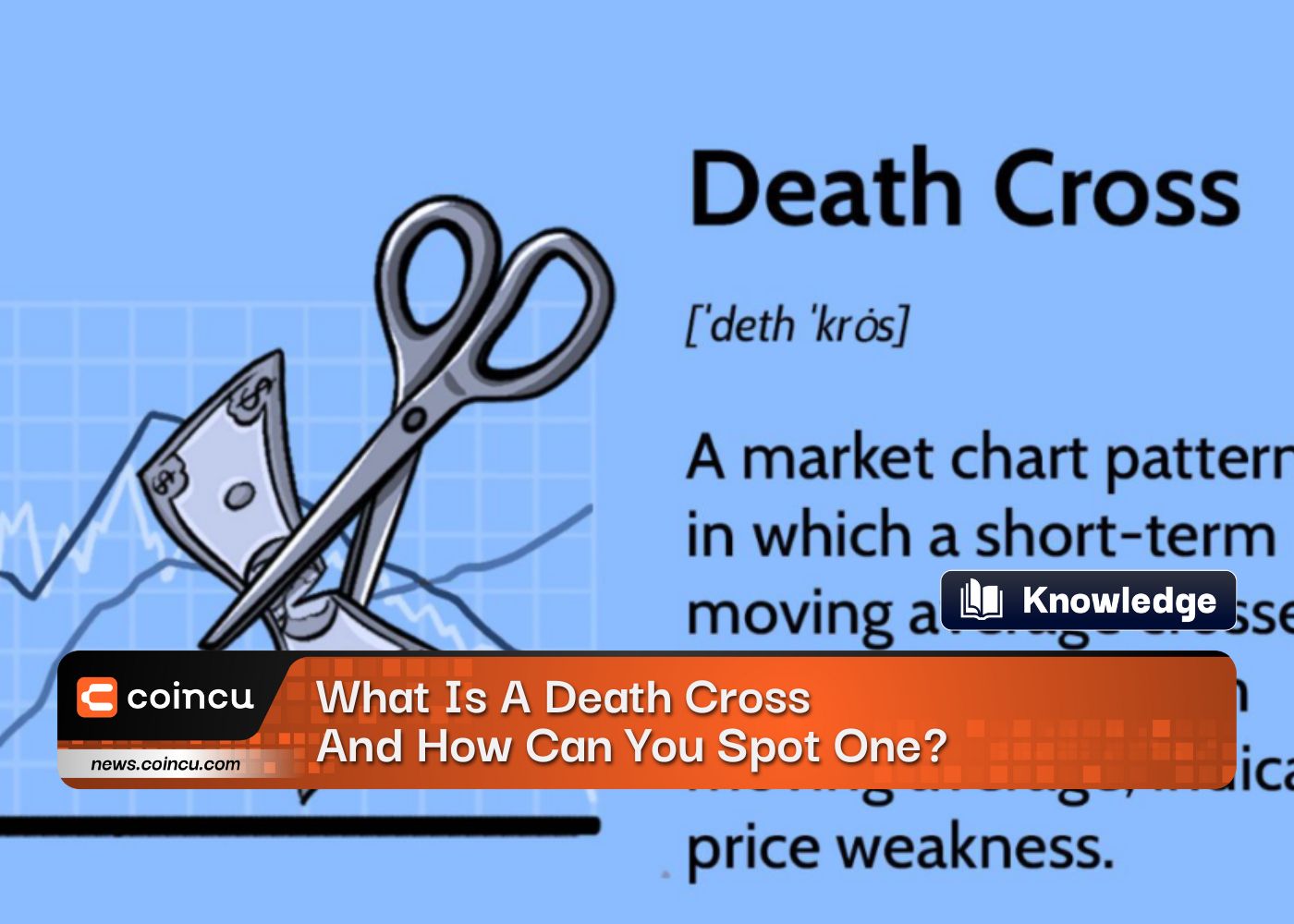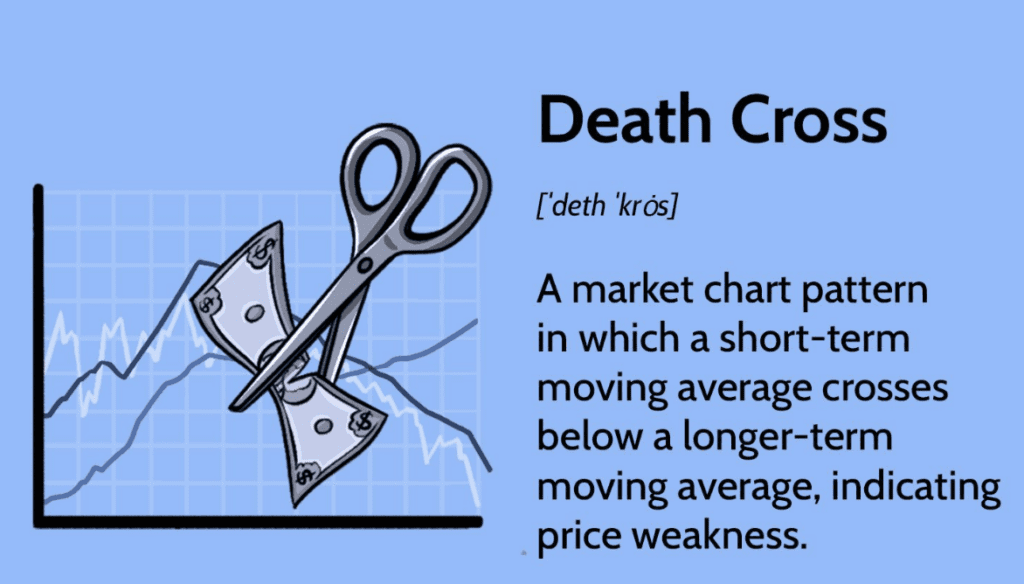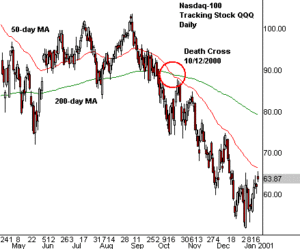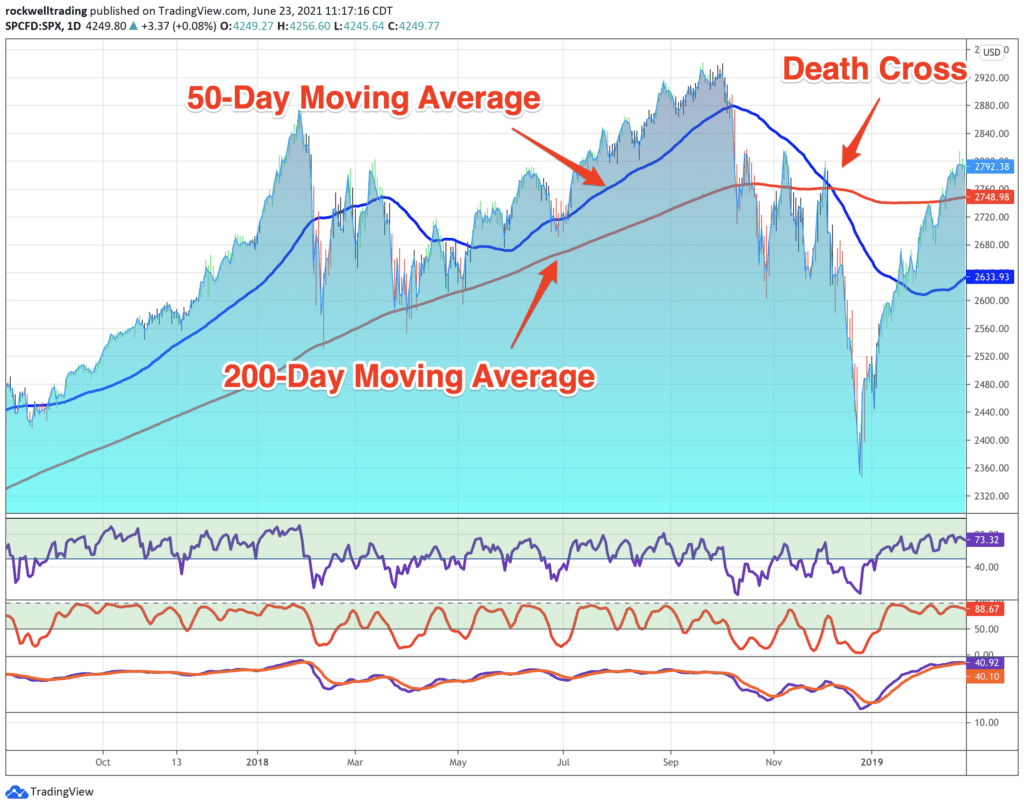What Is A Death Cross And How Can You Spot One?


In the fast-paced world of cryptocurrency trading death cross, it is essential for traders to have the ability to identify market trends before they occur. This is where the importance of analysis comes in. Traders rely on two types of analysis to predict market trends – fundamental analysis and technical analysis.

Fundamental analysis involves studying market sentiment and the various factors that impact it. This includes examining economic indicators, political events, and other news that may affect the market. Technical analysis, on the other hand, focuses on an asset’s price and volume. It involves analyzing charts and identifying patterns that can signal what will happen next.
Technical analysis is usually done by spotting chart patterns that can provide valuable insights into market trends. One such pattern is the death cross. A death cross is a bearish technical analysis pattern that usually heralds the onset of a bear market or downwards trend. It is formed when a short-term moving average crosses below a long-term moving average.
Understanding the significance of a death cross is crucial for traders who want to stay ahead of the game. Knowing how to spot one can help traders make informed trading decisions and avoid losses. In this guide, we will explain what a death cross is, what it tells you and how to spot one. We will also provide tips on how to use this pattern to your advantage in your trading strategy.
What is a death cross?

A death cross is a technical analysis pattern that occurs when the shorter-term moving average of an asset, such as a stock or cryptocurrency, crosses below the longer-term moving average on a price chart. It is often seen as a bearish signal by traders and investors, indicating a potential downward trend or a shift from bullish to bearish sentiment in the market.
In this pattern, the shorter-term moving average, usually the 50-day moving average, crosses below the longer-term moving average, typically the 200-day moving average. The crossing of these moving averages forms a “cross” shape, hence the name “death cross.” It suggests that the recent price movements have weakened and that selling pressure may intensify.
Traders and investors interpret a death cross as a bearish signal because it indicates a potential shift in market sentiment from positive to negative. It signifies that the asset’s recent price decline has gained momentum and could continue in the downward direction. This can be seen as an indication to sell or take a more cautious approach in trading or investing.
To fully comprehend the concept of a death cross, it is important to first understand what moving averages (MAs) are and how they work. A moving average is essentially a line that is plotted over a price chart that calculates the average price of an asset over a specific period of time. MAs are a commonly used tool in technical analysis within the world of cryptocurrency, but it should be noted that they were actually derived from other financial markets.
By analyzing the price chart of a cryptocurrency, we can begin to identify patterns based on moving averages. For instance, when a short-term MA falls below a long-term MA, it often exerts downward pressure on the price action. This specific type of pattern is known as a death cross.
The death cross is just one of many patterns that can be identified through the use of MAs. In fact, there are a variety of different moving averages that can be used to identify various trends and patterns within the cryptocurrency market. Therefore, it is important for traders and investors alike to have a deep understanding of moving averages and how they can be used to inform their trading strategy.
What do death crosses tell you?

The death cross is a well-known technical analysis tool used by traders to predict market trends. It is a signal that indicates when a bull market or an upwards trend is coming to an end. This signal is widely regarded as bearish, and is often seen before major economic downturns.
Death crosses provide traders and investors with important information about potential market trends and shifts in sentiment:
- Bearish Signal: is generally regarded as a bearish signal in technical analysis. It indicates that the shorter-term moving average (e.g., 50-day) has crossed below the longer-term moving average (e.g., 200-day), suggesting a potential shift from bullish to bearish sentiment in the market.
- Potential Trend Reversal: suggests a possible reversal of the previous upward trend or a weakening of the asset’s price. Traders and investors interpret this pattern as an indication that selling pressure may intensify and that a downward trend could be emerging.
- Confirmation of Negative Momentum: confirms the presence of negative momentum in the asset’s price movement. It implies that the recent price declines have gained strength and could continue in the downward direction.
- Selling Pressure: the crossing of moving averages in a death cross pattern can reflect increased selling pressure in the market. It may indicate that more market participants are selling the asset, contributing to a potential decline in its value.
- Timing Opportunities: Traders may use death crosses as timing indicators to make decisions regarding their positions. It can signal a suitable time to sell or take a more cautious approach by reducing exposure to the asset.
- Risk Management: can serve as risk management tools for traders and investors. They provide a visual representation of potential downside risk and help individuals adjust their strategies accordingly, such as implementing stop-loss orders or reducing position sizes.
While the death cross can be a useful tool for traders, it is important to note that it is not always accurate. Traders should not rely solely on the death cross to make decisions about buying or selling. Rather, it should be used in combination with other indicators and analysis tools to make informed decisions.
Traders should also be aware that the death cross is not an immediate sell signal. It takes time for the market to react to the signal, so it is important to monitor the market closely after a death cross appears.
Despite its limitations, the death cross remains a popular tool for traders to use in their technical analysis. By recognizing when a bull market is likely to come to an end, traders can make informed decisions about when to sell and close positions, helping to minimize potential losses.
How to spot a death cross?

Spotting a death cross involves analyzing price charts and monitoring the movement of moving averages:
- Select the Moving Averages: The most common combination for a death cross is the 50-day moving average and the 200-day moving average. However, you can adjust these values based on your trading preferences and the timeframe you are analyzing.
- Plot the Moving Averages on a Price Chart: Plot both the shorter-term moving average (e.g., 50-day) and the longer-term moving average (e.g., 200-day) on the price chart of the asset you are analyzing. Most charting platforms provide tools to overlay moving averages onto price charts.
- Observe the Intersection: Watch for the point at which the shorter-term moving average crosses below the longer-term moving average. This crossing point is the death cross. It forms a “cross” shape on the chart.
- Analyze the Confirmation: Confirm that the crossing of the moving averages is sustained and not a temporary blip. It is often recommended to wait for a few trading sessions or days to ensure that the death cross is valid and not a false signal caused by short-term price fluctuations.
- Consider the Timeframe: Take into account the timeframe you are analyzing. Death crosses may have different significance depending on whether you are looking at daily, weekly, or monthly charts. Longer timeframes generally carry more weight in terms of signaling a potential trend reversal.
- Validate with Other Indicators: While a DC can provide valuable information, it is advisable to confirm it with other technical indicators, chart patterns, or fundamental analysis. Look for supporting evidence that aligns with the bearish signal generated by the death cross.
Are death crosses reliable?

Although death crosses can be a useful tool for traders, it is important to note that they have their downsides. One of the major downsides of relying solely on death crosses is that they may provide false signals, causing investors to react in ways that do not reflect the true market trends. For example, in 2016, a death cross occurred within the market, and investors were prepared for the worst. However, the market trends did not change as expected, leaving many traders confused and uncertain about what to do next. Therefore, while a death cross can be a reliable indicator of market trends, traders should always exercise caution and take into account other factors that may be at play, such as political events, economic indicators, and overall market sentiment. By doing so, traders can ensure that they are making informed decisions that accurately reflect the current state of the market, rather than relying solely on one indicator that may not always play out as anticipated.
Pros and cons of analyzing death cross patterns
Pros:
- Trend Reversal Identification: can help identify potential trend reversals in the market. They indicate a shift from bullish to bearish sentiment, providing traders with insights into potential price declines and opportunities to adjust their positions accordingly.
- Clear Visual Signal: The formation of a death cross on a price chart provides a clear visual signal that can be easily recognized. Traders who are familiar with this pattern can quickly identify it and use it as a basis for their trading decisions.
- Confirmation Tool: can serve as confirmation tools when used in conjunction with other technical indicators or chart patterns. By validating a bearish signal generated by a death cross with additional analysis, traders can increase their confidence in their trading strategies.
- Risk Management: Analyzing death crosses can assist in managing risk by providing warning signs of potential price declines. Traders can implement risk management techniques such as setting stop-loss orders or reducing position sizes to protect against downside risk.
Cons:
- Lagging Indicator: are lagging indicators because they rely on historical price data. By the time a death cross is formed, a significant portion of the price decline may have already occurred. This lag can result in missed opportunities or delayed responses to changing market conditions.
- False Signals: Like any technical analysis tool, death crosses can generate false signals. In certain market conditions, the crossing of moving averages may not accurately predict future price movements. Traders should be cautious of relying solely on death crosses and consider other indicators or analysis methods for confirmation.
- Subjectivity and Interpretation: The interpretation of death crosses can vary among traders. The choice of moving averages, timeframes, and other factors can influence how traders identify and interpret these patterns. This subjectivity can lead to different outcomes and potentially conflicting signals.
- Market Context Dependency: The reliability of death crosses depends on the broader market context. External factors, news events, or market sentiment can influence the significance of a death cross. Traders should consider the overall market conditions and other indicators to validate the signal.
- Timeframe Sensitivity: The significance of a death cross can vary depending on the timeframe being analyzed. Shorter timeframes may produce more frequent and less impactful death crosses, while longer timeframes may generate more significant signals. Traders need to select the appropriate timeframe based on their trading strategies and goals.
Conclusion
Death crosses are a popular technical analysis tool used to identify potential trend reversals and bearish signals in the market. They can provide traders with valuable insights into possible price declines and opportunities for adjusting positions.
The pros of analyzing death cross patterns include their ability to visually indicate trend reversals, serve as confirmation tools when combined with other indicators, and assist in risk management by identifying potential downside risk.
However, it’s important to consider the cons as well. Death crosses are lagging indicators, meaning they rely on historical price data and may result in missed opportunities or delayed responses. False signals can also occur, and the interpretation of death crosses can be subjective. The reliability of death crosses is dependent on the broader market context, and the significance of the pattern can vary based on the timeframe analyzed.
To overcome the limitations, it’s recommended to use death crosses in conjunction with other technical indicators, chart patterns, and fundamental analysis. Traders should also consider market conditions, volume patterns, and external factors to validate the signal and make well-informed trading decisions.
DISCLAIMER: The Information on this website is provided as general market commentary and does not constitute investment advice. We encourage you to do your own research before investing.
Join us to keep track of news: https://linktr.ee/coincu
Annie
Coincu News
What Is A Death Cross And How Can You Spot One?


In the fast-paced world of cryptocurrency trading death cross, it is essential for traders to have the ability to identify market trends before they occur. This is where the importance of analysis comes in. Traders rely on two types of analysis to predict market trends – fundamental analysis and technical analysis.

Fundamental analysis involves studying market sentiment and the various factors that impact it. This includes examining economic indicators, political events, and other news that may affect the market. Technical analysis, on the other hand, focuses on an asset’s price and volume. It involves analyzing charts and identifying patterns that can signal what will happen next.
Technical analysis is usually done by spotting chart patterns that can provide valuable insights into market trends. One such pattern is the death cross. A death cross is a bearish technical analysis pattern that usually heralds the onset of a bear market or downwards trend. It is formed when a short-term moving average crosses below a long-term moving average.
Understanding the significance of a death cross is crucial for traders who want to stay ahead of the game. Knowing how to spot one can help traders make informed trading decisions and avoid losses. In this guide, we will explain what a death cross is, what it tells you and how to spot one. We will also provide tips on how to use this pattern to your advantage in your trading strategy.
What is a death cross?

A death cross is a technical analysis pattern that occurs when the shorter-term moving average of an asset, such as a stock or cryptocurrency, crosses below the longer-term moving average on a price chart. It is often seen as a bearish signal by traders and investors, indicating a potential downward trend or a shift from bullish to bearish sentiment in the market.
In this pattern, the shorter-term moving average, usually the 50-day moving average, crosses below the longer-term moving average, typically the 200-day moving average. The crossing of these moving averages forms a “cross” shape, hence the name “death cross.” It suggests that the recent price movements have weakened and that selling pressure may intensify.
Traders and investors interpret a death cross as a bearish signal because it indicates a potential shift in market sentiment from positive to negative. It signifies that the asset’s recent price decline has gained momentum and could continue in the downward direction. This can be seen as an indication to sell or take a more cautious approach in trading or investing.
To fully comprehend the concept of a death cross, it is important to first understand what moving averages (MAs) are and how they work. A moving average is essentially a line that is plotted over a price chart that calculates the average price of an asset over a specific period of time. MAs are a commonly used tool in technical analysis within the world of cryptocurrency, but it should be noted that they were actually derived from other financial markets.
By analyzing the price chart of a cryptocurrency, we can begin to identify patterns based on moving averages. For instance, when a short-term MA falls below a long-term MA, it often exerts downward pressure on the price action. This specific type of pattern is known as a death cross.
The death cross is just one of many patterns that can be identified through the use of MAs. In fact, there are a variety of different moving averages that can be used to identify various trends and patterns within the cryptocurrency market. Therefore, it is important for traders and investors alike to have a deep understanding of moving averages and how they can be used to inform their trading strategy.
What do death crosses tell you?

The death cross is a well-known technical analysis tool used by traders to predict market trends. It is a signal that indicates when a bull market or an upwards trend is coming to an end. This signal is widely regarded as bearish, and is often seen before major economic downturns.
Death crosses provide traders and investors with important information about potential market trends and shifts in sentiment:
- Bearish Signal: is generally regarded as a bearish signal in technical analysis. It indicates that the shorter-term moving average (e.g., 50-day) has crossed below the longer-term moving average (e.g., 200-day), suggesting a potential shift from bullish to bearish sentiment in the market.
- Potential Trend Reversal: suggests a possible reversal of the previous upward trend or a weakening of the asset’s price. Traders and investors interpret this pattern as an indication that selling pressure may intensify and that a downward trend could be emerging.
- Confirmation of Negative Momentum: confirms the presence of negative momentum in the asset’s price movement. It implies that the recent price declines have gained strength and could continue in the downward direction.
- Selling Pressure: the crossing of moving averages in a death cross pattern can reflect increased selling pressure in the market. It may indicate that more market participants are selling the asset, contributing to a potential decline in its value.
- Timing Opportunities: Traders may use death crosses as timing indicators to make decisions regarding their positions. It can signal a suitable time to sell or take a more cautious approach by reducing exposure to the asset.
- Risk Management: can serve as risk management tools for traders and investors. They provide a visual representation of potential downside risk and help individuals adjust their strategies accordingly, such as implementing stop-loss orders or reducing position sizes.
While the death cross can be a useful tool for traders, it is important to note that it is not always accurate. Traders should not rely solely on the death cross to make decisions about buying or selling. Rather, it should be used in combination with other indicators and analysis tools to make informed decisions.
Traders should also be aware that the death cross is not an immediate sell signal. It takes time for the market to react to the signal, so it is important to monitor the market closely after a death cross appears.
Despite its limitations, the death cross remains a popular tool for traders to use in their technical analysis. By recognizing when a bull market is likely to come to an end, traders can make informed decisions about when to sell and close positions, helping to minimize potential losses.
How to spot a death cross?

Spotting a death cross involves analyzing price charts and monitoring the movement of moving averages:
- Select the Moving Averages: The most common combination for a death cross is the 50-day moving average and the 200-day moving average. However, you can adjust these values based on your trading preferences and the timeframe you are analyzing.
- Plot the Moving Averages on a Price Chart: Plot both the shorter-term moving average (e.g., 50-day) and the longer-term moving average (e.g., 200-day) on the price chart of the asset you are analyzing. Most charting platforms provide tools to overlay moving averages onto price charts.
- Observe the Intersection: Watch for the point at which the shorter-term moving average crosses below the longer-term moving average. This crossing point is the death cross. It forms a “cross” shape on the chart.
- Analyze the Confirmation: Confirm that the crossing of the moving averages is sustained and not a temporary blip. It is often recommended to wait for a few trading sessions or days to ensure that the death cross is valid and not a false signal caused by short-term price fluctuations.
- Consider the Timeframe: Take into account the timeframe you are analyzing. Death crosses may have different significance depending on whether you are looking at daily, weekly, or monthly charts. Longer timeframes generally carry more weight in terms of signaling a potential trend reversal.
- Validate with Other Indicators: While a DC can provide valuable information, it is advisable to confirm it with other technical indicators, chart patterns, or fundamental analysis. Look for supporting evidence that aligns with the bearish signal generated by the death cross.
Are death crosses reliable?

Although death crosses can be a useful tool for traders, it is important to note that they have their downsides. One of the major downsides of relying solely on death crosses is that they may provide false signals, causing investors to react in ways that do not reflect the true market trends. For example, in 2016, a death cross occurred within the market, and investors were prepared for the worst. However, the market trends did not change as expected, leaving many traders confused and uncertain about what to do next. Therefore, while a death cross can be a reliable indicator of market trends, traders should always exercise caution and take into account other factors that may be at play, such as political events, economic indicators, and overall market sentiment. By doing so, traders can ensure that they are making informed decisions that accurately reflect the current state of the market, rather than relying solely on one indicator that may not always play out as anticipated.
Pros and cons of analyzing death cross patterns
Pros:
- Trend Reversal Identification: can help identify potential trend reversals in the market. They indicate a shift from bullish to bearish sentiment, providing traders with insights into potential price declines and opportunities to adjust their positions accordingly.
- Clear Visual Signal: The formation of a death cross on a price chart provides a clear visual signal that can be easily recognized. Traders who are familiar with this pattern can quickly identify it and use it as a basis for their trading decisions.
- Confirmation Tool: can serve as confirmation tools when used in conjunction with other technical indicators or chart patterns. By validating a bearish signal generated by a death cross with additional analysis, traders can increase their confidence in their trading strategies.
- Risk Management: Analyzing death crosses can assist in managing risk by providing warning signs of potential price declines. Traders can implement risk management techniques such as setting stop-loss orders or reducing position sizes to protect against downside risk.
Cons:
- Lagging Indicator: are lagging indicators because they rely on historical price data. By the time a death cross is formed, a significant portion of the price decline may have already occurred. This lag can result in missed opportunities or delayed responses to changing market conditions.
- False Signals: Like any technical analysis tool, death crosses can generate false signals. In certain market conditions, the crossing of moving averages may not accurately predict future price movements. Traders should be cautious of relying solely on death crosses and consider other indicators or analysis methods for confirmation.
- Subjectivity and Interpretation: The interpretation of death crosses can vary among traders. The choice of moving averages, timeframes, and other factors can influence how traders identify and interpret these patterns. This subjectivity can lead to different outcomes and potentially conflicting signals.
- Market Context Dependency: The reliability of death crosses depends on the broader market context. External factors, news events, or market sentiment can influence the significance of a death cross. Traders should consider the overall market conditions and other indicators to validate the signal.
- Timeframe Sensitivity: The significance of a death cross can vary depending on the timeframe being analyzed. Shorter timeframes may produce more frequent and less impactful death crosses, while longer timeframes may generate more significant signals. Traders need to select the appropriate timeframe based on their trading strategies and goals.
Conclusion
Death crosses are a popular technical analysis tool used to identify potential trend reversals and bearish signals in the market. They can provide traders with valuable insights into possible price declines and opportunities for adjusting positions.
The pros of analyzing death cross patterns include their ability to visually indicate trend reversals, serve as confirmation tools when combined with other indicators, and assist in risk management by identifying potential downside risk.
However, it’s important to consider the cons as well. Death crosses are lagging indicators, meaning they rely on historical price data and may result in missed opportunities or delayed responses. False signals can also occur, and the interpretation of death crosses can be subjective. The reliability of death crosses is dependent on the broader market context, and the significance of the pattern can vary based on the timeframe analyzed.
To overcome the limitations, it’s recommended to use death crosses in conjunction with other technical indicators, chart patterns, and fundamental analysis. Traders should also consider market conditions, volume patterns, and external factors to validate the signal and make well-informed trading decisions.
DISCLAIMER: The Information on this website is provided as general market commentary and does not constitute investment advice. We encourage you to do your own research before investing.
Join us to keep track of news: https://linktr.ee/coincu
Annie
Coincu News

